Key takeaways
- Understanding and engaging with community leaders is essential for effective campaign outreach, focusing on building genuine relationships rather than just seeking votes.
- Face-to-face interactions and personalized communication strategies significantly enhance trust and support from community members, highlighting the importance of authentic engagement.
- Collaborative events foster unity among diverse community leaders, creating opportunities for shared goals and relationships to flourish beyond individual agendas.
- Measuring success in community involvement relies on the quality of relationships and trust established, rather than solely on attendance at events.
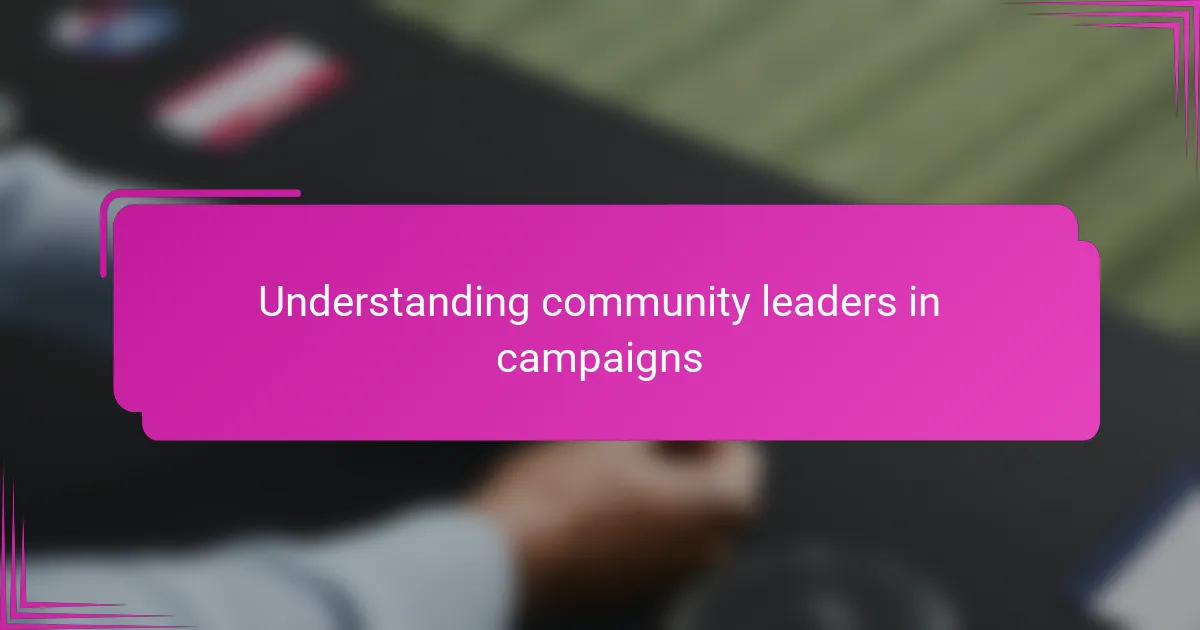
Understanding community leaders in campaigns
In my experience, understanding who community leaders really are goes beyond just knowing their titles or positions. These individuals are the trusted voices in neighborhoods—they’ve built relationships over years, sometimes decades. Have you ever noticed how a pastor’s word or a local business owner’s recommendation can sway opinions more effectively than any ad campaign? That’s the kind of influence I learned to respect and tap into.
Community leaders aren’t a monolith; they come in all shapes and sizes, from formal officials to grassroots organizers and even informal mentors. Early on, I realized that listening carefully to their unique concerns made all the difference in connecting our campaign’s message to the people it needed to reach. It’s about more than strategy—it’s about genuine respect and understanding what motivates them and their communities.
Sometimes I found it challenging to discern who truly holds sway, especially in a town with multiple competing leaders. This made me ask: how do you identify the authentic voices versus the ones just holding a title? The answer, I discovered, is to engage directly, ask questions, and observe where people’s trust naturally falls. It’s a nuanced process that can make or break a campaign’s grassroots efforts.
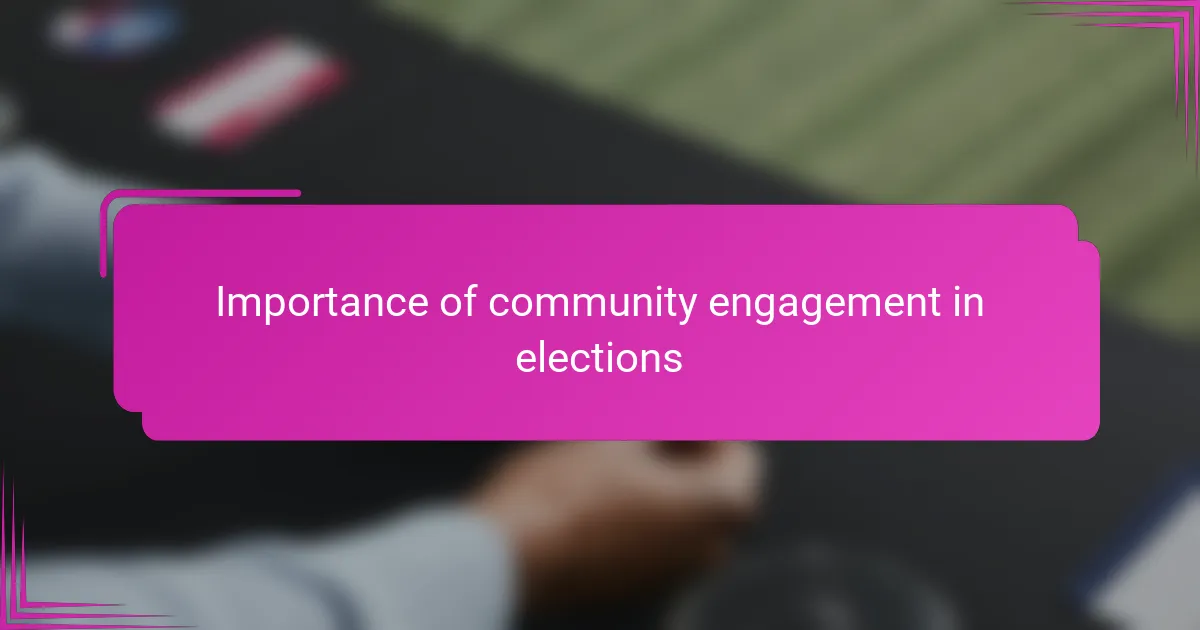
Importance of community engagement in elections
Community engagement isn’t just a box to check during elections; it’s the heartbeat of any successful campaign. I’ve seen firsthand how a community that feels heard and valued responds with enthusiasm and loyalty. When people know you’re genuinely interested in their concerns, they become more than voters—they become advocates.
Have you ever noticed how conversations at a local diner or town hall reveal real issues that no poll can capture? That’s why taking the time to engage directly with community members offers insights you can’t get from data alone. It builds trust in a way that campaign slogans never can.
I remember one election where a simple neighborhood meet-and-greet turned into a powerful moment of connection. Listening to a community elder share concerns about local schools wasn’t just enlightening—it was a reminder that engagement is about relationships, not just votes. Those moments stick with me and shape how I approach every campaign.
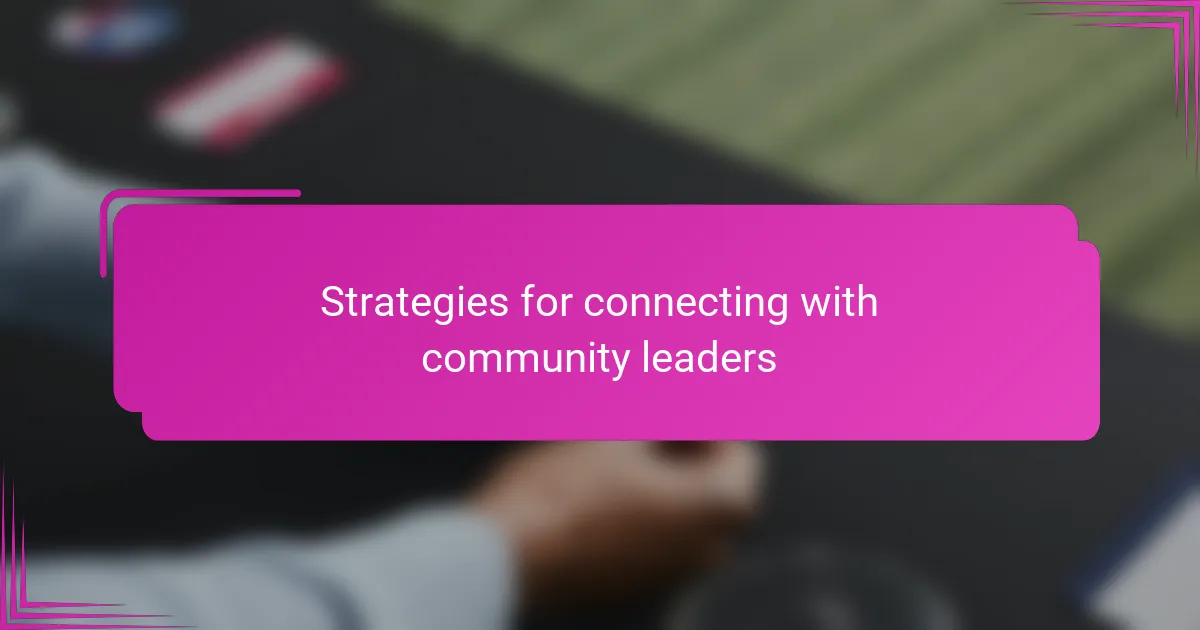
Strategies for connecting with community leaders
One strategy that truly worked for me was prioritizing face-to-face meetings over impersonal calls or emails. I recall sitting down with a local business owner who was initially skeptical; by simply listening and showing genuine interest, I gained not just his support but his enthusiasm to rally others. Have you ever noticed how breaking bread together can open doors that paperwork never will?
I also found that tailoring conversations to each leader’s unique priorities made all the difference. For example, when talking to a youth mentor, we focused on education and job opportunities, whereas with faith leaders, the discussion centered more on community values and family stability. This approach wasn’t a shortcut—it was about respecting their worldviews and aligning our campaign’s message with what they truly cared about.
Lastly, I realized the power of consistency. Checking in regularly, not just during election cycles, helped build authentic relationships over time. One pastor told me, “You’re not just here for the vote; you’re here for us.” That statement stayed with me and reinforced the importance of showing up, again and again, beyond the campaign season. Doesn’t that kind of loyalty make all the difference?
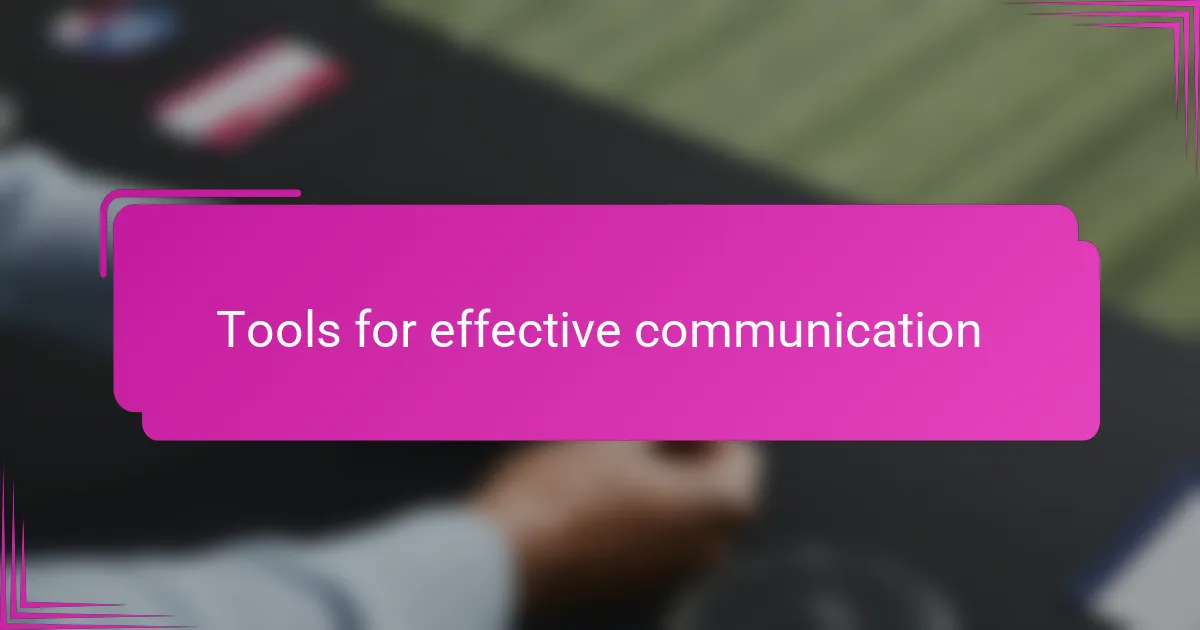
Tools for effective communication
When it comes to tools for effective communication, I’ve found that nothing beats a well-crafted, personalized message that fits the audience. Have you ever sent a generic email and watched it disappear into a black hole? That taught me early on the importance of customizing our communication tools—whether it’s handwritten notes, targeted texts, or tailored social media posts—that resonate on a personal level.
Voice calls and video chats became indispensable tools for me, especially when travel wasn’t feasible. I remember nervously dialing a key community leader and, through that conversation, building a rapport that later translated into valuable support. These tools keep the dialogue real and immediate, bridging distance and showing you care enough to speak directly.
Yet, technology alone isn’t enough. I relied heavily on listening tools—whether digital surveys or informal feedback forms—to gauge what community leaders were truly thinking. It’s amazing how much you learn when you stop talking and start genuinely listening, using these tools not just to talk at people but to engage with them meaningfully. Have you tried asking open-ended questions and letting the answers guide your next move? That’s the essence of using communication tools effectively.
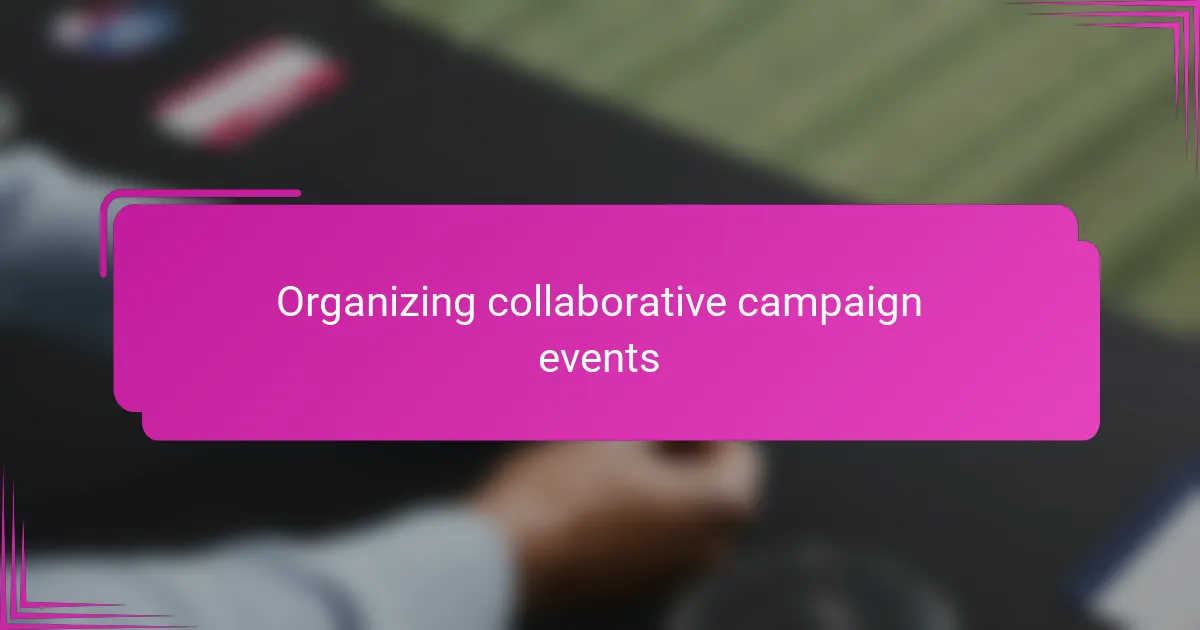
Organizing collaborative campaign events
Collaborative events became the cornerstone of our campaign’s strategy to unify community leaders. I vividly recall organizing a forum where pastors, business owners, and grassroots organizers all sat at the same table. It was more than just a meeting; it was a chance to witness firsthand how shared concerns and collective energy could spark momentum that no single effort alone could achieve.
Have you ever noticed how a well-planned event creates a ripple effect beyond the scheduled agenda? In one instance, a casual conversation at a campaign picnic led to a local entrepreneur volunteering to host future gatherings—something that never would have happened without that initial collaborative space. It reinforced my belief that these events are organic opportunities for leadership and enthusiasm to flourish.
Timing and respect played a huge role in making these events successful. I learned to schedule gatherings around community calendars, avoiding busy seasons or cultural holidays, showing leaders that the campaign prioritized their commitments. That kind of thoughtful coordination wasn’t just appreciated—it built trust and showed we weren’t asking for favors, but for partnership.
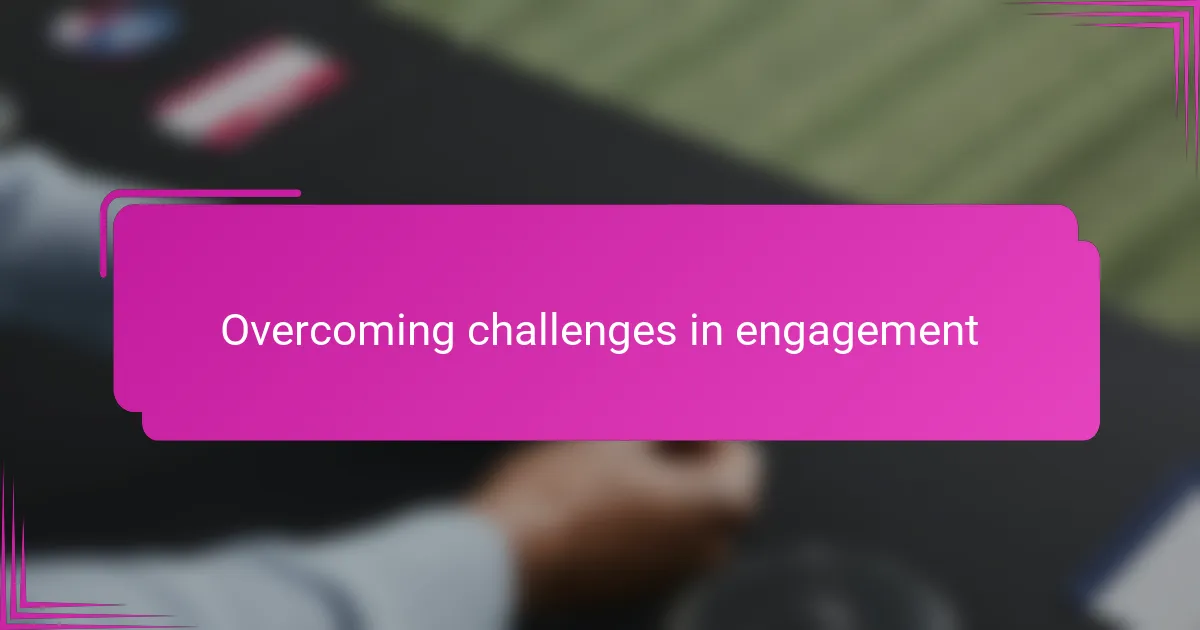
Overcoming challenges in engagement
Overcoming challenges in engagement often felt like navigating a maze without a clear map. I remember facing skepticism from some leaders who’d been burned by empty promises before, making me question how to break through that wall of distrust. Have you ever wondered what it takes to turn doubt into dialogue? For me, persistence and authenticity became the key—showing up consistently and following through on even the smallest commitments helped chip away at barriers.
At times, logistical hurdles like conflicting schedules or limited resources threatened to stall meaningful conversations. I quickly learned that flexibility was essential—sometimes it meant meeting early in the morning or late in the evening, or even shifting venue locations at the last minute. These adjustments weren’t mere inconveniences; they signaled respect for leaders’ time and priorities, which, in my experience, opened doors that rigid planning never could.
There were also moments when competing priorities within the community created tension, and trying to engage everyone felt like juggling flaming torches. It was tough, but focusing on shared goals rather than individual differences helped keep conversations constructive. Have you noticed how emphasizing common ground can transform a challenging meeting into a productive partnership? That insight shaped how I approached conflict and collaboration throughout the campaign.

Measuring success in community involvement
Measuring success in community involvement isn’t always straightforward. I often asked myself, was it the number of leaders who showed up to events or the depth of conversations that really counted? Over time, I realized that genuine engagement is reflected less in attendance stats and more in the quality of relationships built and the trust earned.
Tracking tangible outcomes helped me put things into perspective. For instance, when a trusted pastor publicly endorsed our campaign or a local business owner organized volunteers, those moments became clear markers of impact. But even small gestures, like leaders sharing feedback or inviting me back to listen again, felt like quiet victories that signaled a thriving connection.
I also learned that success shows itself in the ripple effects within the community. When engagement sparks new collaborations or when leaders begin reaching out to each other independently, that’s when you know your efforts truly took root. Have you witnessed how a single conversation can multiply influence beyond what any one person could do? That’s the kind of success that’s worth measuring.